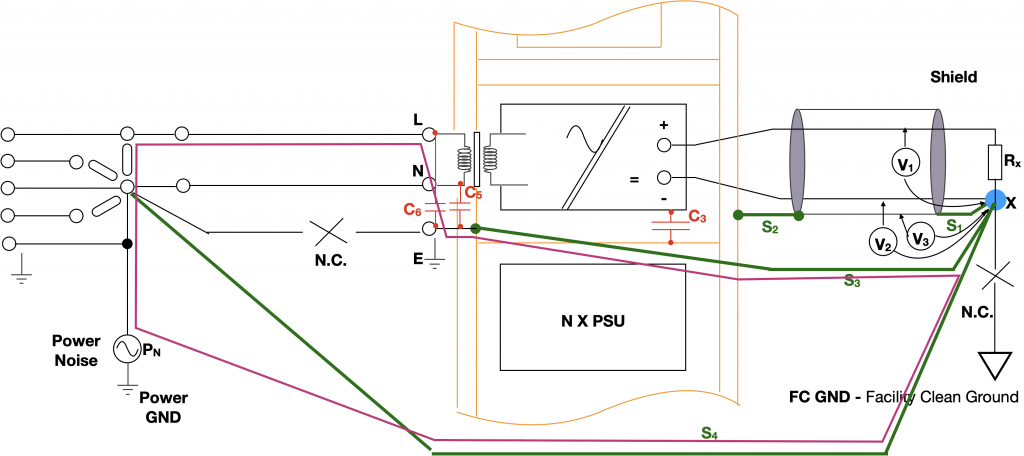By Dr. Min Zhang, the EMC Consultant
Grounding and shielding has always been a challenging issue when it comes to large system installations. Even the most experienced engineers in prestigious companies often get the system installation wrong, intentionally or unintentionally.
In this article, we discuss the grounding and shielding techniques using a practical case study. In this case, the system under the discussion is an instrumentation system used for a space project. The ground loop created by the ground wires lead to loop issues, several solutions are discussed to address this issue.
The system
For demonstration purposes, we can treat the DUT as a pure resistive load, the signal needs to be measured is the voltage across the receiving load RX. The load is ‘grounded’ to the facility clean ground. Note that there is an X symbol at the bottom of the RX, the X symbol represents the ‘star’ point, a reference point often used in space application (As a satellite floats in the space, there cannot a ‘ground’ point, hence the ‘star’ point from historical reasons).
For minimal noise voltage received by RX, all three conductors (DC+ line, DC- line and the shield) should ideally have zero RF voltage difference with regards to the ‘star’ point X. Wire bonding strap S1 and S2 are crucial to ‘close the field’ inside the shield. It has been found that the shield also needs to be connected to the ‘star’ point via a ground wire strap S3 to ensure V3=0.

Noise introduced by the Ground Loop
Due to the parasitic capacitance between the V+ and the inner shield (C1) and the parasitic capacitance between the V- and the inner shield (C2), RF noise voltages are developed, therefore V1,2 are not zero. This is particularly true when the connection between the PSU and the EUT is long.
The DUT is powered by tens of DC power supplies, all of which are galvanically isolated from the metal racks. However, the internal assembly of the power supply unit (PSU) represents significant parasitic capacitance C3 with regards to the rack frame, typically 50 nF per unit. In case where the rack frame is connected to the primary power supply ground, the residual noise marked PN of the three-phase current imbalance will be transferred to the DUT line via C3.

It is easy to break the loop, isn’t it?
It looks easy to break the loop by disconnecting S6. In order to achieve a ‘clean’ break, we also need to make sure the earth wire is cut. Note that special preventions are required to comply with personnel safety requirements. But this disconnection is not a clean break from RF noise point of view. Because the power supply unit has an input filter which includes Y capacitors to earth. These capacitors now provide the noise path as shown below:


We therefore need to further break the loop, this can be achieved by the following configuration. Breaking the connection between the ‘star’ point and the facility clean ground is the key, because now the ‘star’ point X is the same ground potential as the power ground, so there is a very small potential difference between the two ground points, this will prevent current from using C3. The ground strap S4 is important to achieve minimum potential difference between the two ground points.

The proposed solution provides the minimum configuration for such an instrumentation. The grounding scheme can be further improved by the following optimum configuration. The key component in this configuration is the mains isolation transformer unit which consists of two shields. The double shielded transformer is specially made for best attenuation of primary-to-secondary noise transfer, i.e. transfer capacitance C4 is mined to <10nF.
